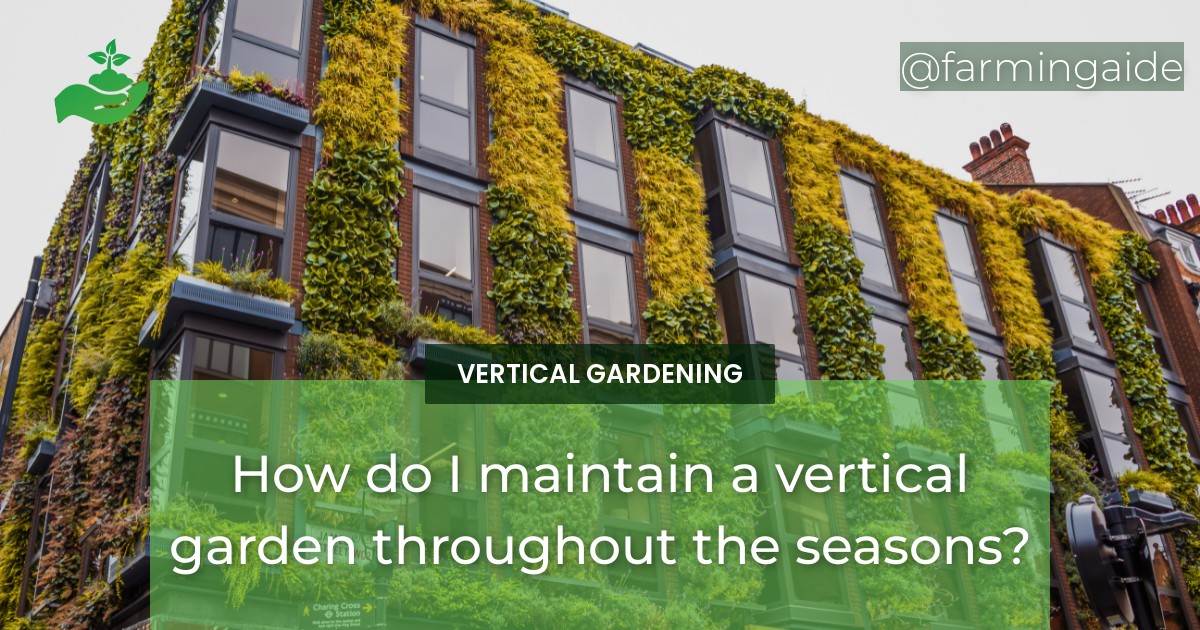A vertical garden is an excellent way to grow plants in small spaces, and it can be a beautiful addition to any home or yard. However, keeping your vertical garden healthy and thriving throughout the year can be a challenge.
In this article, we will cover all the necessary information you need to know to maintain a vertical garden throughout the seasons.
Table of Contents
Seasonal Maintenance Tasks for Vertical Gardens
Spring
– Inspect your plants for any damage that may have occurred over the winter.
– Prune any dead or damaged leaves and limbs.
– Clean the planting containers and replace any damaged or worn-out parts.
– Add new soil and compost to the planting containers.
– Start planting new seeds or seedlings.
Summer
– Water your plants regularly to prevent them from drying out in the heat.
– Provide shade for plants that are sensitive to high temperatures.
– Fertilize your plants every two to three weeks to promote growth.
– Harvest your produce regularly to encourage new growth.
Fall
– Remove any dead plants or weeds from your garden.
– Cover your garden with a protective blanket to prevent frost damage.
– Plant cold-tolerant crops such as kale, spinach, and lettuce.
Winter
– Move your vertical garden indoors or to a sheltered location to protect it from freezing temperatures.
– Reduce watering frequency as plants will grow slower during the winter.
– Use grow lights to ensure your plants receive enough light.
Protecting Plants from Extreme Weather
High Temperatures
– Provide shade for plants that are sensitive to high temperatures.
– Water your plants regularly to keep them hydrated.
Low Temperatures
– Move your vertical garden indoors or to a sheltered location to protect it from freezing temperatures.
– Cover your garden with a protective blanket to prevent frost damage.
Strong Winds
– Secure your vertical garden to prevent it from falling over or becoming damaged.
– Use windbreaks such as fences or screens to protect your plants.
Heavy Rainfall
– Ensure your vertical garden has proper drainage to prevent waterlogging.
– Cover your garden with a protective blanket to prevent damage from heavy rain.
Adjusting Watering and Fertilizing Routines
Watering
– Water your plants regularly, but do not overwater them.
– Adjust watering frequency based on the season and weather conditions.
– Use a watering can or hose attachment with a gentle spray to avoid damaging your plants.
Fertilizing
– Use organic fertilizers to promote healthy growth.
– Fertilize your plants every two to three weeks during the growing season.
– Reduce fertilization frequency during the winter.
Choosing the Right Plants for Your Vertical Garden
Consider the Climate
– Choose plants that are well-suited to your climate.
– Research the ideal temperature and humidity ranges for your plants.
Consider the Sunlight
– Choose plants that are appropriate for the amount of sunlight your vertical garden receives.
– Some plants require full sun, while others prefer partial or full shade.
Consider the Soil
– Use high-quality soil that is rich in organic matter.
– Consider the pH level of your soil and choose plants that are suited to it.
Consider the Watering Needs
– Choose plants that have similar watering needs.
– Group plants together based on their watering requirements.
Dealing With Pests and Diseases in Your Vertical Garden
Common Pests and Diseases
– Common pests include aphids, spider mites, and whiteflies.
– Common diseases include powdery mildew and leaf spot.
Prevention Tips
– Use companion planting to repel pests.
– Keep your garden clean and free of debris.
Treatment Options
– Use organic pesticides and fungicides.
– Remove infected plants to prevent the spread of disease.
Tools and Equipment for Maintaining Your Vertical Garden
Basic Tools
– Gloves
– Pruning shears
– Watering can or hose attachment
Optional Tools
– Grow lights
– Windbreaks
– Protective blankets
Maintenance Schedule
– Create a maintenance schedule to ensure you stay on top of tasks such as pruning, watering, and fertilizing.
– Adjust your schedule based on the season and weather conditions.
In conclusion, maintaining a vertical garden throughout the seasons requires careful attention to seasonal tasks, weather protection, watering, fertilizing, pest and disease prevention, and the right tools. By following the tips and strategies outlined in this article, you can keep your vertical garden healthy and thriving all year round.
RELATED ARTICLES:


